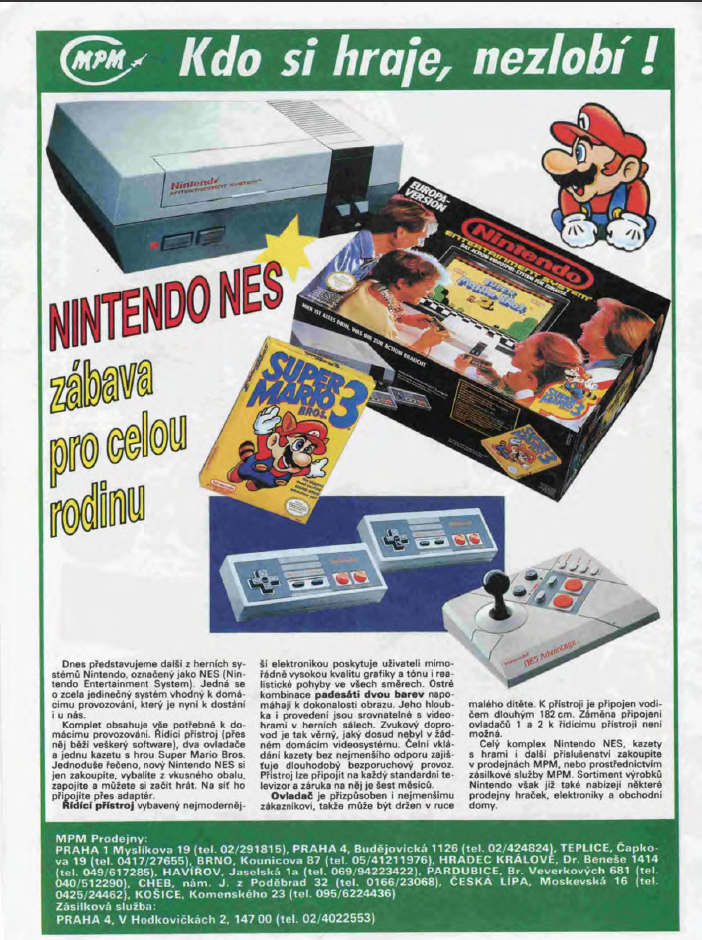Platform: Nintendo Entertainment System
The Three Stooges
Castlevania III: Dracula's Curse
Back to the Future
Milon's Secret Castle
Super Mario Bros. 3
Treasure Master
Armadillo
Little Nemo: The Dream Master
Battle City
Final Lap
Spot: The Video Game
Hudson's Adventure Island
Super Mario Bros.
Chubby Cherub
The Krion Conquest
Devil World
Star Trek V: The Final Frontier
Baby Boomer
Pro Wrestling
Castlevania
Joe & Mac
Mr. Gimmick
Street Fighter
Rambo
Where in Time is Carmen Sandiego?
Faria: A World of Mystery and Danger!
Crystalis
Dr. Jekyll and Mr. Hyde
Who Framed Roger Rabbit
Blaster Master
Maniac Mansion
Tiny Toon Adventures
Joust
Teenage Mutant Ninja Turtles: Tournament Fighters
Adventures of Lolo 3
Super C
Iron Tank: The Invasion of Normandy
Zelda II: The Adventure of Link
Dragon Warrior III
Sid Meier's Pirates!
Final Fantasy
Wacky Races
Dragon Power
Mega Man 5
Mike Tyson's Intergalactic Power Punch
Ninja Gaiden
Metal Storm
Mach Rider
Tagin' Dragon
Mario Bros. Classic Serie
Viewing Single Trivia
▲
2
▼
Popular conceptions about Nintendo's release history in Europe claim that their hardware was never released in the former Eastern Bloc until the 21st century. Rather, these countries instead saw the proliferation of various clone consoles called "Famiclones", such as the Dendy (a Taiwanese-built bootleg that achieved widespread popularity in the Commonwealth of Independent States, made up of the ex-republics of the former Soviet Union) and the Pegasus (which became as popular in Poland as the Dendy did in Eastern Europe). However, while Famiclones did indeed dominate the Eastern European gaming market during the 1990s, Nintendo was not only aware of this, but actively attempted to halt the spread of bootlegs in these regions in favor of officially sanctioned products.
In 1994, Nintendo made a deal with Steepler, the Dendy's distributor in Eastern Europe, to permit continued sale of the Dendy in exchange for equal distribution of the Super Nintendo Entertainment System and Game Boy in the Commonwealth of Independent States; official Russian releases of these systems even included Dendy stickers on the packaging to reflect the arrangement. Meanwhile, in various other parts of the former Eastern Bloc, Nintendo made deals with other third-party distributors; among others, the NES, SNES, and Game Boy saw official releases in Poland, Hungary, and the former territories of Yugoslavia and Czechoslovakia during 1993–1994.
In 1994, Nintendo made a deal with Steepler, the Dendy's distributor in Eastern Europe, to permit continued sale of the Dendy in exchange for equal distribution of the Super Nintendo Entertainment System and Game Boy in the Commonwealth of Independent States; official Russian releases of these systems even included Dendy stickers on the packaging to reflect the arrangement. Meanwhile, in various other parts of the former Eastern Bloc, Nintendo made deals with other third-party distributors; among others, the NES, SNES, and Game Boy saw official releases in Poland, Hungary, and the former territories of Yugoslavia and Czechoslovakia during 1993–1994.
Joshua Rogers video about Nintendo in Eastern and Central Europe:
https://www.youtube.com/watch?v=q75Re7deJC0
Russian-language articles about the Nintendo/Steepler deal:
https://web.archive.org/web/20190427025842/https://www.kommersant.ru/doc/94004
https://web.archive.org/web/20240601223552/https://dtf.ru/games/970617-legenda-o-slone-kak-it-kompaniya-steepler-sozdala-dendy-i-osnovala-rossiiskii-konsolnyi-rynok
https://www.youtube.com/watch?v=q75Re7deJC0
Russian-language articles about the Nintendo/Steepler deal:
https://web.archive.org/web/20190427025842/https://www.kommersant.ru/doc/94004
https://web.archive.org/web/20240601223552/https://dtf.ru/games/970617-legenda-o-slone-kak-it-kompaniya-steepler-sozdala-dendy-i-osnovala-rossiiskii-konsolnyi-rynok
Comments (0)
You must be logged in to post comments.
